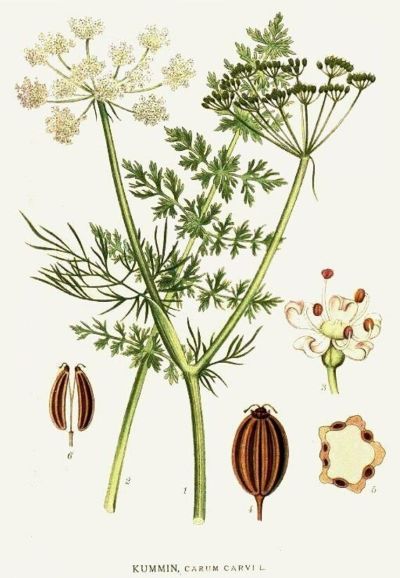Caraway
Caraway
Carum carvi L.
Family Apiaceae (Umbelliferae)
Caraway Description
Caraway is a biennial herbaceous plant, 30–80 cm tall, with a spicy aroma. The taproot is up to 20 cm. The stem is erect, furrowed, branched in the upper part. Leaves are bipinnatifid, with linear segments, 5–15 cm. Flowers are small, white or pinkish, collected in compound umbels (3–6 cm). Fruits are crescent-shaped achenes, 2–3 mm, grayish-brown, with a distinct essential oil. Varieties include: 'Efirny 99', 'Ranniy'. It blooms in June–July, fruits in July–August. Popular internationally, often without specific named cultivars being widely recognized outside of specialized agriculture, as it's primarily grown for its seeds.
Habitat and Ecology of Caraway
Its homeland is the Mediterranean and Western Asia. It grows wild in Europe, Siberia, Central Asia, and North Africa. It is cultivated in Russia, Ukraine, Belarus, Europe, and North America. It prefers loose, neutral soils (pH 6.0–7.0), sunny locations, and irrigation of 10–15 L/m² every 7–10 days. It reproduces by seeds (sowing in April–May). Yield: 0.5–1.5 kg/m² of seeds. Care: loosening, potassium fertilization (20–30 g/m²), protection from aphids and carrot flies.
Caraway Raw Material
Raw materials: fruits (fructus Carvi), herb (herba Carvi), essential oil (oleum Carvi). Fruits are harvested in July–August when 50–60% are mature, plants are mowed, dried at 30–40 °C, threshed (yield 20–25%). The herb is harvested in June–July, dried at 25–35 °C (yield 15–20%). Quality: fruits – grayish-brown, 2–3 mm, essential oil ≥3–7%; herb – green; moisture ≤12%. Store in airtight containers (fruits: 2 years; herb: 1 year). Spicy smell, pungent taste.
Chemical Composition of Caraway
Fruits: essential oil (3–7%, carvone 50–65%, limonene 30–40%), fatty oil (15–20%), proteins (15–20%), carbohydrates (up to 35%), vitamins (C up to 21 mg%, B1, B2), minerals (K, Ca, Fe, P), flavonoids, coumarins. Herb: essential oil (0.1–0.3%), flavonoids. Calorie content of fruits: 333 kcal/100 g.
Action and Application of Caraway
Caraway has carminative, antispasmodic, diuretic, expectorant, antiseptic, and lactogenic effects. It is used for flatulence, colic, dyspepsia, gastritis with low acidity, bronchitis, cough, hypertension, metabolic disorders, and lactation. The fruits stimulate appetite and improve digestion. Essential oil is used for neuroses and insomnia. The herb is used for gargling in cases of angina and stomatitis.
Caution for Caraway Application
Consumption of seeds >5 g/day or essential oil >5 drops/day may cause nausea, dizziness. Children under 3 years old – no more than 0.5 g/day. Pregnant women should avoid high doses due to the risk of uterine stimulation. Store oil at 0–5 °C in a dark place for no longer than 1 year. Wash fruits thoroughly due to possible pesticides.
Contraindications for Caraway Application
Allergy to Apiaceae, peptic ulcer, gastritis with high acidity, pregnancy (high doses), lactation, epilepsy.
Caraway Recipes
- Seed Infusion for Flatulence. Pour 200 ml of boiling water over 2 g of seeds, infuse for 15 minutes, drink 50 ml 3 times a day for 5 days.
- Herb Decoction for Cough. Boil 10 g of herb in 200 ml of water for 10 minutes, drink 50 ml twice a day for 7 days.
- Oil for Colic. Take 3–5 drops of essential oil on sugar twice a day for 3 days.
- Infusion for Lactation. Pour 200 ml of boiling water over 1 g of seeds, infuse for 20 minutes, drink 50 ml twice a day for 10 days.
- Caraway Tea for Digestion. Steep 1 teaspoon of caraway seeds in a cup of hot water for 5-10 minutes. Drink after meals to aid digestion and reduce bloating.
- Caraway Infused Oil. Gently warm caraway seeds in a neutral oil (like olive or sunflower) for a few minutes. Let cool and strain. Use this oil for massages to relieve muscle aches or for cooking.
Caraway Cosmetics
Caraway is used for skin and hair care, reducing inflammation.
- Lotion for Acne. 5 ml of essential oil, 50 ml of water, wipe the skin, once a day for 7 days.
- Mask for Oily Skin. 10 g of ground seeds, 10 ml of honey, apply for 15 minutes, rinse, twice a week.
- Hair Rinse. Pour 200 ml of boiling water over 15 g of seeds, infuse for 20 minutes, rinse hair, once a week.
- Compresses for Inflammation. Pour 100 ml of boiling water over 10 g of herb, infuse for 15 minutes, apply for 10 minutes, twice a day.
- Caraway Essential Oil for Skin Blemishes. Dilute 1-2 drops of caraway essential oil with a carrier oil (like jojoba or almond oil) and dab onto blemishes.
Caraway Culinary Uses
Seeds are used as a spice in bread, cheeses, soups, and pickling. The herb is used in salads and teas.
- Caraway Bread. 500 g flour, 5 g seeds, 300 ml water, 10 g yeast, 10 g salt, bake for 40 min at 200 °C.
- Sauerkraut with Caraway. 1 kg cabbage, 5 g seeds, 20 g salt, ferment for 5–7 days.
- Tea for Flatulence. Pour 200 ml of boiling water over 1 g of seeds, infuse for 10 minutes, drink 100 ml twice a day.
- Caraway Soup. 200 g potatoes, 100 g carrots, 5 g seeds, 1 L water, boil for 20 minutes.
- Roasted Root Vegetables with Caraway. Toss diced carrots, parsnips, and potatoes with olive oil and caraway seeds, then roast until tender and slightly caramelized.
- Goulash with Caraway. Incorporate caraway seeds into hearty stews like goulash for a distinctive, warm flavor.
- Caraway Cheese. Many cheeses, particularly in Northern Europe, are flavored with caraway seeds, adding a pungent and aromatic note.
Tips: Store seeds in a dark place for up to 2 years, grind before use to preserve aroma.
Other Properties of Caraway
Used as a honey plant, in perfumery, soap making, and for flavoring liqueurs.




